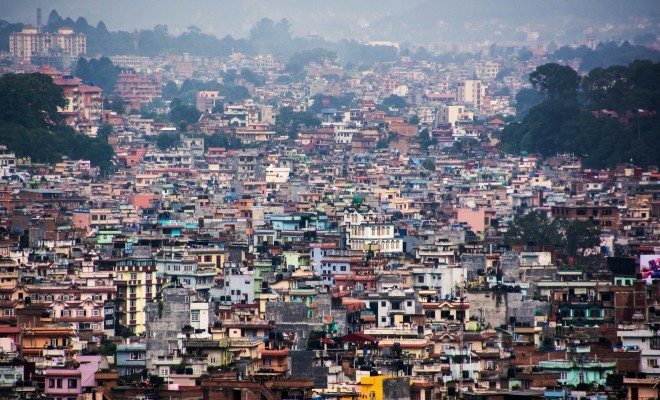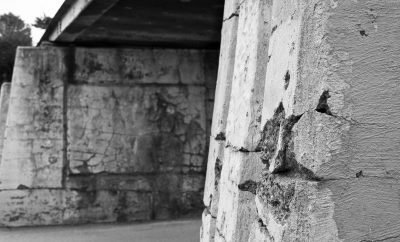 Image courtesy of [Sharada Prasad CS via Flickr]
Image courtesy of [Sharada Prasad CS via Flickr]
Energy and Environment
Some Cities Survive Natural Disasters Better Than Others For This Reason
The death toll from the recent 7.8 magnitude earthquake in Nepal has surpassed 7,000, with at least 14,000. Recovery efforts have been underway for the last week. As people attempt to repair the damage and their lives, we should reflect on the implications of this disaster.
The bulk of the damage, casualties, and relief efforts are centered around the capital city of Kathmandu. Thousands of people have been left homeless and are forced to sleep and wait outdoors, as open spaces seem to be the only places that are safe from aftershocks. Because relief organizations are short on tents by the hundreds of thousands, they are exposed to the rain, cold air, and other elements. Furthermore, hospitals are not designed to accommodate for the scale of injuries. A 120-year-old hospital building was forced to relocate its patients elsewhere for operations.
Another long-term concern is Nepal’s economy. Many temples and historic sites have collapsed from the quake, which not only is spiritually disheartening for the nation’s religious population, but those sites have served as attractions for tourists in the city. In addition, the 2015 climbing season at Mount Everest is over, as climbers died in earthquake-induced deadly avalanches. At least 17 people died there, with dozens more injured and missing. While some climbers have been rescued by helicopter, others were trapped too high on the mountain, beyond the reach of air rescue. Yet they were hard pressed to descend on their own because the avalanches and quakes restricted access to their normal climb and descent routes.
Ongoing aftershocks continue to jar rocks and snow from the mountain, making rescue efforts difficult and dangerous. This disaster has already surpassed last year’s avalanche that killed 16 people as the single deadliest event on Everest, and it is expected to continue to worsen. Furthermore, it is unclear at what point climbing will resume and what form it will take; the damage from the quake and avalanches may have altered the topography of the mountain, which would force a readdressing of climbing routes, number of climbers that can be accommodated, and other details of this nature. Climbing Everest is one of the primary sources of tourism and income for the nation.
Most of the modern structures in the city of Kathmandu, while damaged, remained intact; on the other hand, most of the damage inflicted was on the old, poorly constructed brick buildings in the urban area. The city, region, and nation are generally hampered by poverty and have undergone substantial increases in population, experience poor coordination in building, and often do not adhere to building codes. These things make the region much more vulnerable when disasters of this caliber occur. It is quite similar to the 2010 earthquake in Haiti. That one was also quite large in strength, registering at a 7.0 on the Richter Scale, but the death toll is estimated as high as 220,000. This catastrophic figure is due to the extreme poverty, poor building, and insufficient infrastructure that is rampant in Port-au-Prince. Conversely, the strongest earthquake on record, the 1960 9.5 tremor in Chile, resulted in approximately 2,000-3,000 deaths. The difference, journalist Jerry Thompson argues, resulted largely from more sophisticated building techniques, more preparedness on the part of the populace, and better organized rescue services in this more economically developed nation.

Poor quality building in Kathmandu. Courtesy of Oliphant via Flickr.
Thompson has also written about a massive subduction zone fault line near the North American Pacific Northwest coast. He suggests it is overdue for a massive quake, which would induce an enormous tsunami that could cause untold devastation in the area. We might say that Nepal is fortunate to be landlocked; in the 2004 Indian Ocean earthquake and tsunami, most of the deaths occurred as a result of the latter disaster rather than the former. The Fukushima nuclear meltdown was also spurred by the tsunami and not the quake itself. Understanding the functions of the natural world and that these two events may go hand in hand may lead to more foresighted planning.
There may be additional non-human damages that result from such problems. For example, the 1906 San Francisco earthquake did not cause as much damage as the fire that followed, which nearly gutted the entire city. The fire sprung up in many areas at once, largely due to a combination of broken and leaking gas pipes interacting with sparking downed power lines, and proceeded to devour the largely wooden buildings. It became clear even to the people at the time that the damage and deaths were due to poor planning on their part; nature was not to blame. Yet nature suffered nonetheless. The poorly built water supply system failed, and a beautiful valley in Yosemite National Park drowned as dams were built to meet the city’s water needs.
We must come to understand that we are a part of the Earth, not occupiers of it. Natural disasters will occur, and there will be fatalities. But they do not need to be as horrific as they are. The massive inequalities in wealth, technology, and living standards throughout the world have reared their ugly heads during disasters like this. It is encouraging to see so many other nations and organizations rallying to assist and support, but addressing the underlying problems that are ever present would be productive for societies’ lived experiences year round as well as in times of crisis. The tragedy in Nepal reminds us of the lesson that we have failed to grasp: since these forces are too powerful for us to control, and to an extent–since tectonic activity is vital to all life and the planet itself–should not be controlled, we must learn to live with them safely and intelligently.








Comments